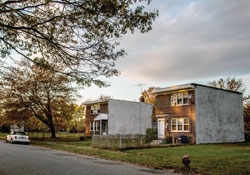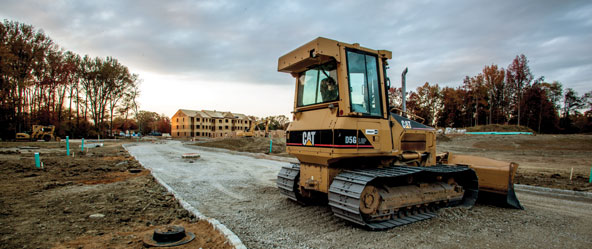Did town show disparate-impact bias in taking over buildings?

Few houses remain in Mount Holly Gardens, which is being replaced by a new development that is the subject of a fair housing case coming before the Supreme Court this month. Photo by Colin M. Lenton.
A housing discrimination case from New Jersey could lead to one of the biggest decisions of the U.S. Supreme Court’s term. On the other hand, if it proceeds like another recent fair housing case, it could end up a dud.
The justices granted review of Mount Holly v. Mount Holly Gardens Citizens in Action Inc. at the end of their last term. It is slated for argument Dec. 4 on the question of whether disparate-impact claims of discrimination may be brought under the federal Fair Housing Act of 1968.
Two terms ago, the Supreme Court was slated to take up that question in a case involving claims of disparate-impact bias in the city’s regulation of rental properties in St. Paul, Minn. The question is significant not just for housing issues at the building and city levels, but for banks, mortgage companies, the insurance industry and other entities covered by the fair housing law.
Fearing that the conservative majority on the high court might find that the Fair Housing Act does not permit disparate-impact claims, President Barack Obama’s administration and civil rights groups convinced the city of St. Paul to settle the case. As the ABA Journal was going to press in November, a tentative settlement was reported in the New Jersey case but had not been finalized. Nevertheless, all sides had already briefed the contentious case.
“This case deals with something we all have to have, which is housing,” says David C. Frederick, the Washington, D.C.-based Supreme Court specialist who will argue for a group of citizens of the Mount Holly Gardens complex. “There are broad or narrow ways for the court to decide this case.”
At issue are claims that the efforts of the township of Mount Holly, population 9,500, to redevelop a deteriorating neighborhood of 329 brick row houses had a disparate impact on the mostly black and Hispanic residents there.
OF BLIGHT AND RIGHTS
In 2000, Mount Holly officials sought to determine whether the neighborhood qualified as an “area in need of redevelopment,” a blighted section that would permit them under New Jersey law to use the power of eminent domain to condemn buildings and rebuild.
The township found many houses in the neighborhood boarded up, with absentee owners and other conditions that contributed to problems with rodents, drugs and crime.
“The increase in absentee landlord-owned property has corresponded … with the decline in housing unit repair and maintenance and yard upkeep,” the township’s 2002 redevelopment report concluded.
The township adopted a redevelopment plan in 2003 that called for acquiring and demolishing all 329 houses in Mount Holly Gardens and replacing them with “the Villages at Parker’s Mill,” a combination of 520 new apartments and townhomes. The plan called for making 10 percent of the new units affordable for low-income residents, with the rest to be sold at market rates. Existing residents would get relocation assistance under the plan.
The township has not resorted to using eminent domain thus far. It has purchased 259 of the 329 row houses over the past decade. Many of the residents in the 70 remaining households face the loss of an affordable home with no guarantee that they would be able to return to the redeveloped neighborhood.
Reviewing the Mount Holly situation, New Jersey’s public advocate concluded in a 2008 report (PDF) that “the law should not permit a municipality to proceed on the assumption that some of its residents, regardless of their economic status, will simply disappear for the convenience of those who remain or who arrive to replace those who have left.”
The residents’ federal suit alleged that the plan was an intentionally racially discriminatory effort to remove minorities from Mount Holly, and that the redevelopment plan had a racially disparate impact. According to the 2000 census, approximately 46 percent of Gardens residents were African-American and 29 percent were Hispanic, compared with 21 percent and 9 percent, respectively, in Mount Holly overall.
A federal district court rejected both claims. The 3rd U.S. Circuit Court of Appeals at Philadelphia agreed in 2011 that there was no valid claim of intentional discrimination, but it allowed the residents’ disparate-impact claim to proceed.
The appeals court held that the plaintiffs’ evidence—which showed that a greater proportion of minorities lived in the Gardens than in Mount Holly township, and that minority household income in surrounding Burlington County was, on average, less than white household income in the county—established a prima facie case that the redevelopment plan “dis-proportionately affects or impacts one group more than another.”
The township appealed to the Supreme Court, where it expects to argue that the text of the Fair Housing Act prohibits only racially disparate treatment, not disparate-impact bias.
Carter G. Phillips, another Supreme Court litigation heavyweight, argues that a decision finding that the FHA permits disparate-impact cases will make it much harder for towns and cities to revitalize their rundown sections.
“It will literally become impossible for any community to deal with a blighted neighborhood because the chances that there won’t be a disparate impact are zero,” says Phillips, who is representing Mount Holly township. “The sense that a city like Detroit will have to deal with its blighted conditions in perpetuity strikes me as absurd.”
Frederick counters on behalf of the Mount Holly Gardens plaintiffs that the FHA does not require discriminatory intent for a violation. He argues, among other things, that the statute contains several exemptions from liability—for drug offenders, for occupancy caps to prevent overcrowding, and for real estate appraisals—that don’t make sense if there is only a discriminatory-intent standard.
“Each of those exemptions creates a carve-out from FHA liability for conduct other than intentionally discriminatory treatment on the basis of race, color, religion, sex, familial status or national origin,” Frederick says in his brief. “If the FHA did not recognize a disparate-impact standard, those exemptions would have no work to do.”
Frederick also points out that 11 federal appeals courts have upheld the disparate-impact standard, and that the U.S. Department of Housing and Urban Development promulgated a final regulation this past February that codified its long-standing interpretation that the FHA recognized disparate-impact claims.
The outcome of the case is important well beyond urban renewal efforts. Banking groups, led by the American Bankers Association, tell the court in an amicus brief that while they are committed to nondiscriminatory lending, bank practices have been challenged on disparate-impact suits under the FHA.

The new development replacing the old in Mount Holly Gardens. Photo by Colin M. Lenton.
VESTIGES PERSIST
Mortgage lenders, governed by a separate provision of the FHA than that at issue in the Mount Holly case, nonetheless worry that a disparate-impact standard could be applied to their practices, including “sensible, risk-based credit standards” that “are highly predictive of applicants’ ability to repay debt” but also “yield lending outcomes across racial and ethnic groups that are disproportionate to their share of the population.”
The insurance industry, meanwhile, is suing HUD over language in its recent regulations suggesting that insurers may be liable on a disparate-impact theory for practices related to the provision and pricing of homeowner’s insurance.
“The fundamental stability of the homeowner’s insurance system would … be severely disrupted if disparate-impact liability were permitted,” industry groups say in their amicus brief.
The Obama administration and civil rights groups were expected to come in on the side of the Mount Holly Gardens residents.
“The importance of disparate impact as a tool in the tool kit to enforce fair housing is particularly critical given that the persistence of discriminatory policies that deny housing opportunities to African-Americans and others has been laid bare by the recent economic crisis,” says Joshua Civin, a lawyer with the NAACP Legal Defense and Educational Fund, which filed an amicus brief on the homeowners’ side.
He notes that even when a racially disparate impact has been shown in housing, the defendant property owner or government has a chance to show that the challenged practice is important to its business interests.
“We’ve made a lot of progress against race discrimination; but especially in housing, the vestiges of real discrimination persist,” Civin adds. “It’s important to have a tool to get at the modern-day forms of discrimination.”
Update: After this magazine went to press, but before arguments were held before the Supreme Court, Mount Holly v. Mount Holly Gardens Citizens in Action Inc. was settled.
This article originally appeared in the December 2013 issue of the ABA Journal with this headline: “When a House Is Not a Home: Residents say town showed disparate-impact bias in taking over buildings.”
Write a letter to the editor, share a story tip or update, or report an error.


